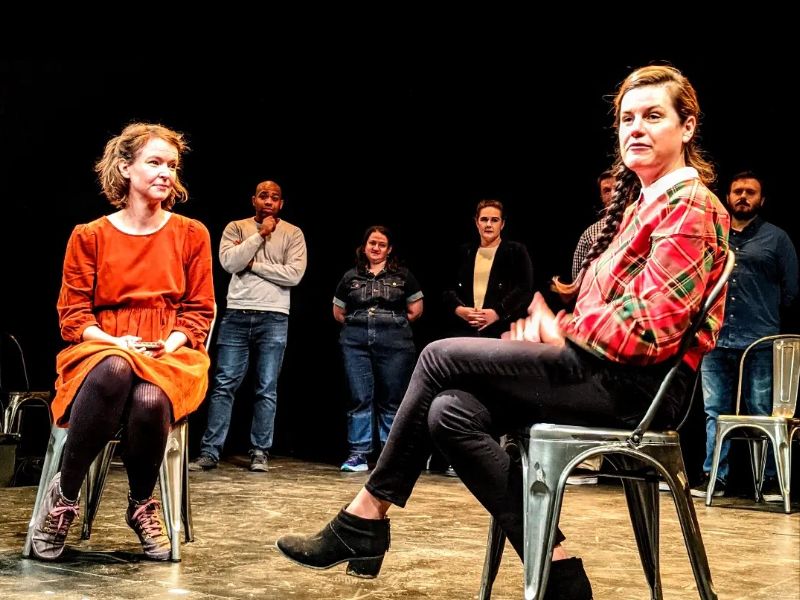By Jakob Cansler
This article was first published in DC Metro Theater Arts here.
Can improv comedy change the world? Can it move society forward, instead of setting it back?
Those are the questions Washington Improv Theater is asking over the course of the next month in its new series now running at Studio Theatre, Ask Me Anything: Changemakers.
Each performance in the series features an interview with a DMV resident who is “working to make the world a better place,” which the improvisers then use as inspiration for a comedic performance right after. WIT has lined up an impressive slate of local activists, artists, and policymakers for the series, and since each night features a different interviewee, every performance is unique for both the performers and the audience.
A recent performance featured Erin Palmer, a DC activist who serves as an Advisory Neighborhood Commissioner (ANC) — a hyperlocal elected volunteer position designed to advise the DC City Council (a job description that Palmer very helpfully explained to the audience). She also recently ran a surprisingly competitive primary challenge against Council Chairman Phil Mendelson.
In the interview portion of the show, Palmer described her background as a lawyer, the experience of local politics, running a campaign against Mendelson, the changes she’d like to see in city government, and what it’s like working with residents to improve her neighborhood and the district at large.
One resident, for example, was obsessed with solving the citywide rat problem, which meant Palmer needed a rat platform.
“What is your rat platform?” an audience member immediately asked.
Palmer’s “rat platform” — dry ice, for what it’s worth — led to a hilarious recurring bit during the improv portion of the show in which the rats of the city campaigned to have their own ANC. The candidate? John Quincy Ratams, who is firmly anti-dry ice and pro-dumpster.
That’s just one example of how the performers spun Palmer’s interview into a unique comedic performance that blended together typical improv techniques with specific local humor. The performers also poked some good-natured fun at neighborhood cleanups, Palmer’s job as a lawyer, and Rock Creek Park.
“I was afraid going in because change-making — sometimes it’s very serious business,” said Bill Nelson, one of the performers, after the show. Instead, Nelson found the discussion to be low-stakes and conversational, so the audience got to hear both the “serious business” and the sillier side of local politics, the latter of which provided inspiration to the improv performers.
The result was a show that took a normally complicated and serious topic and turned it into something accessible and funny.
“I think a lot of people don’t care for local politics,” said Palmer after the show. “When you put it in a way that’s enjoyable and easy to digest and humanizing, that can grow people’s interest, and maybe they’ll see something different that they didn’t see before.”
Indeed, the hope for WIT is that the entire series can have that effect — that the interviews and performances put together can serve as education and inspiration as much as they are entertainment.
“I think it’s really great to get community members like Erin talking about something so important that many people may not be invested in initially,” said Eddison Wilkinson, another performer. “It’s awesome that you get to have a nice, funny night as well as learn about these wonderful, important things in our community.”
Nelson and Wilkinson also said they see a lot of similarities between improv and local politics, and that hopefully a performance like this can help the two distinct fields inform each other.
“One of the key elements of improv — successful improv — is shutting up and listening,” said Nelson. “Clearly, in the world of politics, there needs to be a lot more listening.”
It’s not just local politics, though, that WIT intends to tackle through this production. Coming up, WIT has shows featuring highly acclaimed local artist and activist Holly Bass (November 26), trans activist Charlotte Clymer (December 9), and Dixon Osburn (December 10), who played a pivotal role in dismantling “Don’t Ask, Don’t Tell.”
As a result of the wide variety of guests, each night will be completely unique. For the audience, that means a lot of exciting and distinct viewpoints on change-making. For the performers, it presents a unique challenge and an opportunity for learning and inspiration both onstage and off.
Onstage, Wilkinson said, he tackles that challenge by always thinking: “What can I listen and take away from this person to help us push forward and not just be at a standstill or be at a moment where no one can say anything and no one can move anywhere?”
That question, he said, applies offstage too, and he hopes it’s the question audience members take away from the show. It’s also the question embodied by the slate of guests Washington Improv Theater has lined up.
“It became very clear that Erin Palmer is just an ordinary person who then saw something that needed change,” said Nelson. “I hope that we can all take the idea that no matter how ordinary we are, we can participate. I think that’s pretty inspirational.”


